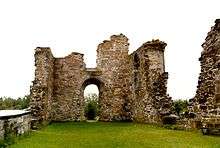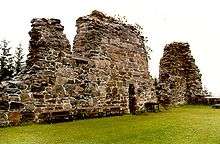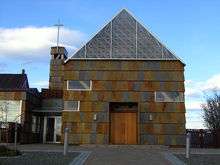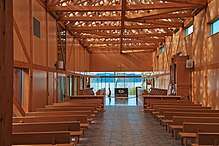Tautra Abbey
Tautra Abbey (Norwegian: Tautra Mariakloster) was a monastery of Cistercian monks founded in the 13th century on the island of Tautra in the Trondheimsfjord in Norway. The island is part of the municipality of Frosta in Trøndelag county, Norway. Tautra Abbey was dissolved during the Reformation in Scandinavia when its lands were passed to the Crown, but the sizeable ruins of the church are still to be seen. The ruins of the former abbey (Tautra klosterruin) are relatively well preserved and are a favorite tourist destination.[1]




Tautra Abbey
The Cistercian monastery of Tautra (Tuterøkloster) was opened on 25 March 1207. It was founded by monks from Lyse Abbey near Bergen. Tautra Abbey had a good strategic and attractive site. The earlier foundation of Munkeby Abbey seems to have been transferred here shortly after the foundation of this house. The abbey grew wealthy and powerful, and its abbots often played a major part in Norwegian politics. The abbey flourished and lasted until the 16th century. Tautra Abbey ceased as an independent monastery in 1532. Tautra Abbey was dissolved during the Reformation in Scandinavia. Its property was placed under the crown in 1537 when it was closed. [2][3]
Tautra Monastery
The present Tautra Monastery (Norwegian: Tautra Mariakloster) is a newly founded Trappistine community, and it is the first permanent Cistercian settlement in Norway since the Reformation. It was founded in 1999, near the ruins of the medieval monastery,[4] as a foundation of Our Lady of the Mississippi Abbey, located near Dubuque, Iowa in the United States. The foundation stone was laid by Queen Sonja of Norway on 23 May 2003. The new monastery was granted general autonomy on 26 May 2006.[5]
On 25 March 2012, the status of the monastery was raised to that of Major Priory in the Cistercian Order. A community of Cistercians monks is in the process of being established nearby, near the former Munkeby Abbey, the first foundation of the Order in what is now Norway. The monk in residence serves as chaplain to the nuns. The new monastery will the first new foundation by the motherhouse of the Order, the Abbey of Cîteaux, since the 13th century.[6]
Ruins of Tautra Abbey
References
- "Tautra klosterruin". Fortidsminneforeningen. Retrieved 2017-11-01.
- Knut A Rosvold. "Tautra" (in Norwegian). Store norske leksikon. Retrieved 2011-05-19.
- "Tautra klosterruin". Visit Frosta. Retrieved November 1, 2017.
- Anne Stensvold. "Cistercienserordenen" (in Norwegian). Store norske leksikon. Retrieved 2011-05-19.
- "History of Munkeby and the new Munkeby Mariakloster". Munkeby Mariakloste. Retrieved 2017-11-01.
- Munkeby Monastery (Munkeby Mariakloster)
Other sources
- Gervin, Karl (2007). Klostrene ved verdens ende (in Norwegian). Pax Forlag. ISBN 9788253030104.
- Lidén, Hans-Emil (1994). "Taura kloster". En reise gjennom norsk byggekunst (in Norwegian). Fortidsminneforeningen. ISBN 9788290052442.
External links
| Wikimedia Commons has media related to Tautra Mariakloster. |




